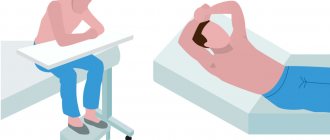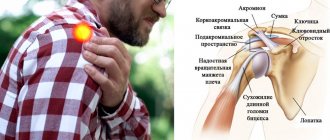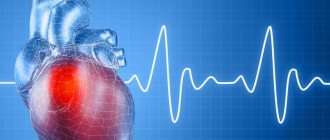Causes
The peculiarities of the sensitive innervation of the chest are due to the large number of internal organs and the close location of the main nerve bundles.
In addition, in medicine they use the concept of crossing zones of external and visceral (from internal organs) sensitivity with the formation of Zakharyin-Ged areas . Therefore, the appearance of sharp pain in the heart from the back is caused by the following conditions:
- injuries to the neck, chest or spine with pinched nerve fibers;
- diseases of the esophagus - tumors, diverticula (pathological protrusions of the muscle wall), strictures (narrowings caused by inflammation), varicose veins or rupture (perforation) of the wall;
- hiatal hernia;
- Osteochondrosis is a degenerative disease affecting intervertebral discs and vertebrae. It is characterized by pathological growth of bone tissue, increased load on the spine with the development of radicular pain syndrome, most often in the thoracic region and lower back;
- intercostal neuralgia - pain that occurs along the nerve (most often in the intercostal spaces), associated with mechanical action (spasmodic muscle or bone growth puts pressure on the nerve fiber, irritating it);
- Myocardial infarction is an acute condition characterized by necrosis (death) of part of the muscle mass of the heart due to impaired blood flow through the coronary vessels. More often it occurs after the rupture of an atherosclerotic plaque, the development of a thrombus (blood clot) or arterial spasm;
- dissecting aortic aneurysm - a violation of the integrity of the vascular wall associated with the leakage of blood between the layers and further destruction of the artery. The pathology is characterized by an acute attack in which the heart hurts and radiates to the back;
- angina pectoris is a variant of coronary heart disease, when compressive pain behind the sternum is observed with irradiation to the back, shoulder blade and left arm after physical activity. The disorder occurs due to a transient decrease in blood flow in the coronary vessels;
- acute bronchitis, tracheitis - inflammatory diseases of the mucous membrane of the respiratory tract.
In elderly patients, with spinal curvatures, and diabetes mellitus, cardiovascular pathologies occur atypically: the heart hurts from the back.
How is back and lower back pain diagnosed?
To make a preliminary diagnosis, the doctor talks with the patient:
- collects complaints (specifies what symptoms of back pain the patient still has);
- is interested in the history of this disease (when the first manifestations occurred, how they changed over time, what affects their intensity and what makes it easier);
- clarifies the life history as a whole (asks what other illnesses the patient had, what his close relatives suffered from).
Then the specialist will conduct an objective examination:
- will examine the affected area of the body, paying attention to the color, cleanliness of its skin, sometimes “by eye” he will detect tense paravertebral muscles, and asymmetry of the spine, when the patient, trying to relieve sensations, takes a forced position;
- palpates (feels with fingers; in this way the doctor will assess the body temperature at the site of the lesion (an increase in it is a sign of an inflammatory process), find the place of maximum pain, detect a spasmed muscle or a deformed vertebra, and if the problem is localized in the abdomen, make a conclusion about which organ caused referred pain);
- if necessary, she will perform percussion or tapping (this method will help determine the lower border of the liver, stomach, kidneys in order to verify the possible pathology of these organs).
Shpidonov Gennady Stanislavovich
Neurologist
Rostov State Medical University (neurology)
10 years of experience
The data obtained at this stage is enough for the doctor to suspect a particular disease. To confirm the diagnosis, he will prescribe additional research methods to the patient:
- clinical blood test (will show the inflammatory process in the body, if any);
- general urinalysis (will exclude kidney pathology);
- Ultrasound of the abdominal organs, retroperitoneum and pelvis;
- radiography of the lumbosacral spine or other, more modern imaging methods (CT or MRI);
- consultations with specialists of other profiles.
Pain in the heart area or back pain?
Cardialgia (“cardia” – heart, “algia” – pain) is a painful sensation in the chest area associated with heart diseases of various etiologies. For patients with heart and back pain, a primary differential diagnosis is performed to determine the urgency and specificity of medical care.
Features taken into account:
- the connection of the attack with physical activity - the appearance of pain, shortness of breath and increased heart rate after the end of exercise indicates cardiac pathology. Pain in the back and heart that occurs after a sharp turn of the torso or head is often associated with pinched nerves;
- respiratory act – pathologies of the respiratory system are characterized by increased pain on inhalation and when coughing;
- eating - an increase in pain is observed when eating hot, cold and solid foods in patients with esophageal pathology;
- nature of the pain - paroxysmal stabbing - with angina pectoris, constant intense cutting - typical for aortic aneurysm, dull for a long time - chronic inflammatory and non-inflammatory heart diseases;
- zones of irradiation - the spread of an unpleasant sensation to the left arm, scapula and lower jaw are characteristic of a heart attack, localization in the upper right part of the chest - a dissecting aortic aneurysm.
In addition, the anamnesis (history of development) of the disease, the progression of the clinical picture and accompanying symptoms are taken into account.
Diseases of the esophagus are characterized by dysphagia (impaired swallowing), sensation of a foreign body behind the sternum, heartburn, and coating on the tongue.
With intercostal neuralgia, a constant pain syndrome is observed: the intensity does not decrease at night, unlike osteochondrosis. Sensitivity disturbances are noted with severe compression of the nerve: the limb goes numb for several hours. A sharp pinching of the nerve root causes the patient’s characteristic posture: leaning forward, the patient holds one side (the affected side) with his hand.
Acute cardiac pathologies (angina pectoris and myocardial infarction) are characterized by the sudden onset of pain, often to the left of the sternum. Additionally, cardiac arrhythmias (tachycardia), loss of consciousness, a feeling of fear of death, and severe shortness of breath are noted.
Localization of pain in the lumbar region
By the location of the pain, one can indirectly judge its possible cause. But it is important to understand that this is just a guess and does not replace consultation with a doctor.
Pain above the lower back, but below the shoulder blades
It may be based on:
- diseases of the lower thoracic and/or lumbar spine of a degenerative-dystrophic, traumatic or other nature;
- osteoporosis;
- muscle pathology (tension, spasm of muscle fibers);
- benign and malignant neoplasms (tumors);
- diseases of the digestive system (pancreatitis).
Pain below the waist
Can talk about the following diseases:
- osteochondrosis of the lumbosacral spine;
- osteoporosis;
- diseases of the gallbladder, intestines;
- pathology of the genitourinary system (pyelonephritis, urolithiasis, inflammation of the ureters).
In women, this symptom may be accompanied by a complicated pregnancy (for example, one with a threat of miscarriage), premenstrual syndrome, and menstruation itself.
Lower back pain that occurs when internal organs are damaged is called referred pain. They are secondary in nature and are accompanied by other symptoms:
- abdominal discomfort;
- bloating;
- nausea, vomiting;
- bowel dysfunction (frequency, constipation);
- increased or difficult urination, pain during urination;
- increase in body temperature.
If there are no other symptoms, and pain occurs after a long stay in one position, heavy lifting or long walking, it is probably associated with problems in the musculoskeletal system, and you should first undergo an examination to exclude this particular cause.
Left lower back pain
Sudden, acute pain in the left side, radiating to the left shoulder blade, the left half of the neck, may be a manifestation of myocardial infarction, requiring emergency treatment. Also, a sudden sharp (“dagger”) pain in this area of a piercing, cutting nature is a sign of perforation of a stomach ulcer. This is a dangerous, even life-threatening condition that you need to be aware of in order to begin treatment as early as possible.
In other cases, this symptom is a sign of a pathological process of the musculoskeletal system:
- posture disorders;
- osteochondrosis;
- radiculitis, radiculopathy.
More often it is aching, occurs during a sedentary lifestyle, after physical activity on the lower back (long walking, sitting), and does or does not go away after rest.
Right lower back pain
Cramping or dull, aching pain may be a sign of kidney disease or reproductive system disease.
A gradually increasing intensity of sensations and pain when touching the affected area indicate the presence of an inflammatory process of an infectious or non-infectious nature.
Sharp, acute pain, like being hit with a dagger, that occurs suddenly is a symptom of perforation of a stomach or duodenal ulcer, internal bleeding, or rupture of the appendix.
Pulling sensations originating in the spine and spreading to the right side are a sign of muscle strains, radiculopathy or other diseases of the musculoskeletal system.
Lower back pain when coughing
The main reasons are the following:
- osteochondrosis;
- facet syndrome (if you relax the muscles on the affected side, reduce the load on the damaged joints, leaning towards them, the intensity of the discomfort decreases);
- herniated disc in the lumbar spine (usually accompanied by decreased sensitivity of the lower extremities or dysfunction of the pelvic organs);
- stenosis (narrowing) of the spinal canal (accompanied by intermittent claudication, impaired sensitivity and movement in the legs);
- radiculopathy;
- kidney diseases.
What examinations to do
The effectiveness of treatment depends on making the correct diagnosis, therefore a clinical examination by a doctor and additional instrumental and laboratory research methods are used:
- electrocardiography (ECG) is a type of recording of the electrical activity of the heart, which is used to diagnose angina and myocardial infarction. The most informative is a recording during an acute attack of pain;
- echocardiography (ECHO-CG) is an ultrasound method for visualizing the chambers of the heart and great vessels. Used to diagnose dissecting aortic aneurysm, valve defects and hemodynamic disorders after a heart attack;
- X-ray of the chest organs - for the diagnosis of rib fractures, acute bronchitis. Examination of the abdominal cavity using contrast helps establish the diagnosis of hiatal hernia. Not administered to women during pregnancy due to the harmful effects of ionizing radiation on fetal development;
- radiography of the spine in the cervical, thoracic and lumbar regions - for the diagnosis of traumatic injuries or osteochondrosis;
- fibrogastroduodenoscopy is an endoscopic method for visualizing the hollow organs of the gastrointestinal tract, which is used to evaluate changes in the mucous membrane of the esophagus and stomach.
Laboratory diagnostics involves determining an increased number of leukocytes (nonspecific markers of inflammation) and troponins (sharply increased - a marker of myocardial infarction).
Oncological diseases
With cancer, pain appears in different areas of the body and can change location regardless of the location of the tumors. Typically, pain appears in the later stages, when the pathology has spread widely and caused serious harm to the person. The entire chest may hurt with lung cancer, and the pain is worst when you cough or breathe quickly. Another symptom of lung cancer may be coughing up blood. In women with breast cancer, there is pain in the chest and radiates to the back.
Treatment options
The attending physician prescribes therapy after analyzing the research results and making a correct diagnosis.
For severe neuralgic pain, the following groups of drugs are prescribed:
- non-steroidal anti-inflammatory drugs - Diclofenac, Nimesil, Movalis (gels - for topical use, powder - for the preparation of oral solution);
- diuretics - to relieve edema (Furosemide, Hydrochlorothiazide, Spironolactone);
- reduction of muscle spasm – “Mydocalm”;
- improvement of metabolic processes - B vitamins (“Neurorubin”).
For cardialgia (angina or heart attack), the following treatment tactics are used:
- vasodilators: “Nitroglycerin” – one tablet under the tongue;
- antiplatelet drugs (lowering blood viscosity): Acetylsalicylic acid, Clopidogrel, Ticagrelor;
- oxygen therapy.
In case of a heart attack, anticoagulant agents are used (Heparin, Enoxaparin). Restore blood flow through the damaged area using percutaneous coronary intervention (stent placement).
For pain of other origin, depending on the diagnosis, the following treatment regimen is used:
- acute bronchitis or tracheitis - antipyretic and antitussive drugs, inhalations with antiseptic solutions. If necessary, antibacterial therapy;
- dissecting aortic aneurysm - urgent surgical intervention;
- diseases of the esophagus – antisecretory drugs (“Ranitidine”, “Pantoprozol”); ruptures, diverticula and hernias require surgical treatment.
For patients whose back pain radiates to the heart, nonspecific therapy is started after excluding acute myocardial ischemia, aortic dissection, or esophageal rupture.
How to relieve an attack of lower back pain?
If this symptom occurs as a manifestation of a spinal disease, you should:
- reduce the load on the spine as much as possible (ideally, lie on a flat, hard surface, first on your stomach, and after 5 minutes carefully roll over onto your back and raise your legs to reduce the tension on the nerves);
- apply an anti-inflammatory drug to the skin of the lower back, or inject an NSAID drug into the gluteal muscle, or take such a drug in tablet form (preferably not on an empty stomach);
- after the intensity of the sensations has decreased, carefully stand up and secure your lower back with a scarf or a special corset.
If back pain is reflected - arose against the background of somatic pathology, taking an antispasmodic will help alleviate the person’s condition. You should not apply heat to the area of pain - it can aggravate the inflammatory process, if any.
conclusions
The appearance of pain localized in the sternum is caused by pathologies of the heart and structures located behind the pericardium. Determining the underlying cause by detailing the pain syndrome (character, intensity, irradiation and connection with breathing, physical activity and food intake) helps to choose further diagnostic tactics.
More often, pain of such localization is characteristic of myocardial ischemia or damage to nerve fibers. Patients who have aching heart or back are prescribed instrumental and laboratory procedures that confirm a certain diagnosis, after which adequate therapy is selected, aimed at eliminating both the symptom and the cause of the pain.
Cardiac dyspnea - treatment
A guaranteed way to cope with shortness of breath is to treat the underlying disease. The earlier the diagnosis is made and the tactics chosen, the faster shortness of breath, pain and other unpleasant symptoms will go away.
When heart failure is compensated and impaired heart functions are restored, health will gradually return to normal. The body will not need to breathe faster to saturate the blood with oxygen.
If treatment for heart failure has already begun, but shortness of breath still persists, increase sports activity gradually, under the supervision of a doctor. Don't try to run a marathon straight away.
Be sure to monitor the condition of your heart and blood vessels. Remember: the more risk factors in your life, the higher the likelihood of recurrent cardiovascular disease.
Reason 3. Intervertebral hernia
Intervertebral hernia is the “squeezing out” of the nucleus pulposus by neighboring vertebrae. The nucleus pulposus is a kind of hinge that is located in the center between the vertebrae and ensures their mobility. Therefore we can bend in all directions. But this structure is semi-liquid, and with increased or sudden physical activity it can “crawl” beyond the intervertebral space, forming a hernia.
The pain is acute, pronounced, and sharply intensifies with exercise. May be accompanied by impaired sensitivity in the arms and legs, numbness and pain in the extremities, and radiate to the buttock.
An intervertebral hernia can be diagnosed by an orthopedist, neurologist, neurosurgeon, or vertebrologist.
Diagnostics
Since pain in the back and chest can simultaneously be a sign of a large number of diseases and pathologies, it is possible to make an accurate diagnosis only after conducting examinations and passing the necessary tests. The list of diagnostic measures is compiled by the doctor. You cannot engage in self-diagnosis and self-medication. What may be included in the diagnosis when a patient presents with the following complaints:
- collecting information about the patient’s problem and health status;
- examination, which includes listening to the heart and lungs, measuring blood pressure and pulse;
- X-ray, which makes it possible to evaluate the work and condition of the heart, lungs, spine and ribs;
- An ECG
is prescribed to evaluate heart function; - CT and MRI
make it possible to clarify the condition of internal organs and the presence of pathologies; - FEGDS and gastroscopy are prescribed for problems with the gastrointestinal tract.
Laboratory tests may also be ordered. An accurate diagnosis can only be made by a doctor after a complete examination of the patient.






